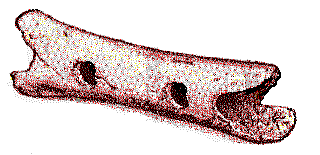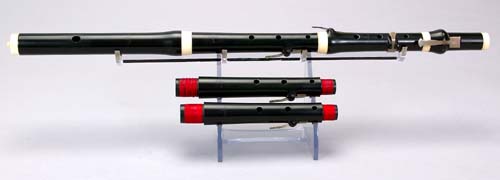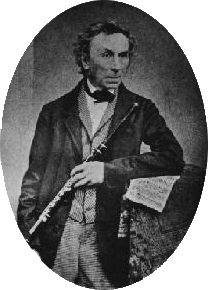For publications, click on the bouncing white ball below
The evolution of the European Transverse Flute

Neanderthal Bone Flute ca. 50,000 B.C.
Found by Dr. Ivan Turk, of the Slovenian Academy of Science. It was excavated from a campsite in Ljubljana, Slovenia, in 1998. It is the oldest known musical instrument, made from the femur of a cave bear. It has two complete, and two partial holes.
Early Flutes
Byzantine paintings from as early as the 10th Century portray a transverse flute, often played to the left instead of to the right. Bronzes and wall paintings from this period also show evidence of the existence of transverse flutes. These early examples more closely resemble fifes than they do our modern conception of the flute.
c. 1320 - One-piece wooden flute; 2' long, key of "D"
1511 - Zwerchpfeiff; narrower, with 6 finger-holes
1529 - Descant, alto, tenor and bass versions appear
![]()
Keyless cylindrical flute, ca. 1550
1619-20 - Praetorius' SYNTAGMA MUSICUM portrays three Querflotten, with 2-octave ranges
1636 - Flutes Allemands appear, keys of "D" and "G", with new cylindrical bore, made of wood
1670 - Three-piece, 1-keyed flute in "D" appears in Jean-Baptiste Lully's famous orchestra in France. More changes: conical bore (tapers down to middle, placing the holes closer together) and smaller finger-holes

Hotteterre fingering chart, 1707
1720 - Middle joint is divided in half, called corps de rechange, 2 keys added
1722 - Famous flutist and composer Quantz adds tuning cork in headjoint and C# key on footjoint
Johann Joachim Quantz, 1697 - 1773
1726 - E-flat & D-sharp keys added on footjoint (two separate keys) by Quantz while he was in Paris.

Borkens, 1735
1760 - G#, B-flat, & F keys added by London makers Florio, Gedney, & Potter
![]()
Boxwood flute with three corps de rechange, ca. 1760
1782 - Maker J.H. Ribock adds closed C key
c. 1790 - 4 keyed flutes appear in the symphonic music of Mozart and Haydn.
![]()
Classical flute, ca. 1795
1800 - B-flat lever added for 1st finger of right hand
c. 1800 - The flute starts appearing in the symphonies of Beethoven

Grenser Classical Flute, ca. 1800
1806-48 - Claude Laurent makes 3, 4, and 7 keyed glass flutes
1808 - Rev. Frederick Nolan invents open holes (rim only, finger-pad covers hole) . He proposed the construction of open-standing keys, either with a single lever or a linked pair.
1810 - George Miller in London, starts making metal bores
1812 - Tebaldo Monzani puts knobs on the mouth-hole
1814 - James Wood in London makes three tuning slides

Late classical flute, 1818
1821 - Rudall & Rose start making 8-keyed flutes, which become popular in England
1822 - The Nicholsons (father and son) adjust the key positions and make a flute with a narrower bore
1824 - Maker Pottgiessen invents the ring and crescent key
The Boehm Era

Theobald Boehm (1794-1881) was born in Munich. He was a talented goldsmith and skilled at the mechanical arts. An avid flute player, he also served as a Royal Bavarian Court Musician. His workshop was in his own home and he worked with a partner, Greve, to design and build his flutes. The Boehm flute is the accepted standard today and Boehm's discoveries were truly revolutionary. His key system was adapted to all other woodwind instruments as well.
Boehm's Developments
c. 1810 - Boehm builds his first model and tinkers with keys, springs (to control key tension), and pads
![]()
Boehm old system flute, 1829
c. 1829 - Finger-holes are still too far apart, so Boehm begins developing a completely new fingering system, even building his own machine for boring holes, pillars, posts, and flat gold springs (the new system uses rods to connect all the keys, thus the need for posts, springs, etc.)
1830 - Boehm's new model is finished
1831 - Boehm presents his new model in Paris and London performances
![]()
Boehm new system flute, 1832
1832 - Boehm is inspired by hearing flute virtuoso Charles Nicholson; he changes from standard covered holes to ring keys (see Rev. Nolan; 1808) or "open holes", producing clearer tone and better intonation. He also aids finger action by adding a thumb crutch for the left hand.
Boehm and Others
![]()
Godefroy cocus wood flute with Dorus G# key, ca. 1832
1833 - Gordon's experimental Diatonic Flute features crescent-shaped touchpieces
1834 - The Boehm Flute gains popularity with French and German professional flutists.
1837 - Auguste Buffet (Paris instrument maker) improves on Boehm - changing axles, hole placements, lugs, rods, and sleeves (the latter hold the rods and axles together)
1838 - Buffet and collaborator Coche, add D# trill key and "Dorus" G# key
1839 - Flutemaker Ward manufactures the Boehm flute in London
c. 1840 - Rudall & Rose begin manufacturing Boehm flutes in London, along with Clair Godfroy in Paris
1846-47 - Boehm experiments with a cylindrical bore based on a "parabolic curve" (17 mm. in diameter at top of instrument to 19 mm. in the middle of the body). Also, he enlarges the embouchure to a quadrangular shape, producing a fuller, clearer tone, and he compiles his Schema for finger hole placement. Pads are improved by covering the inside of closed keys with felt and the rims of open keys with skins, which are held together with screws and washers.
1846 - Boehm experiments with different metals. He decides on silver, finding it to possess the best tone quality, while being the least fatiguing to play.
![]()
Rudall, Rose, and Carte with Dorus G# key, ca. 1847
1847 - Boehm sells rights of manufacture to Rudall & Rose and Clair Godfroy/Louis Lot in Paris. His famous tome, The Flute and Flute Playing: In Acoustical, Technical and Artistic Aspects, is published by B. Schott's Söhne of Mainz .
1847 - Boehm Flutes are imported to New York City.
1849 - Composer Briccialdi adds the thumb B-flat key
![]()
Rudall and Rose, ca. 1851
1855 - Boehm Flute wins gold medal at Paris Exhibition, to general acclaim. New players are making great technical advances thanks to Boehm's mechanical breakthroughs.
1860 - Boehm flutes adopted as the official instrument of the Paris Conservatory
1877 - Boehm perfects his "modern silver flute". The Macauley Flute is silver, with a gold embouchure. It has gold springs, a B foot, and is unsurpassed by any of Boehm's creations.
Macauley flute, 1877
End of 19th Century - The flute appears with an expanded technical capacity in the orchestral scores of Brahms, Strauss, and Tchaikovsky. Solo literature is produced by many composers, with virtuosic showpieces becoming the fashion. Flutes are able to play music which had been too technically demanding for pre-Boehm instruments. The extended range used by composers of the Romantic era demands a flute which can play in excess of three octaves.
Post-Boehm - The 20th Century
1948 - Alexander Murray, well-known flutist and teacher, collaborates with makers Albert Cooper and Elmer Cole, on the "Murray" flute - based on the "Cooper experimental" scale, and with a "corrected" C# key.
1961-62 - Murray's next model, the "Mark I" appears
1967 - Murray collaborates with Jack Moore, a well-known maker with the Armstrong Company
1972 - Murray and Moore bring out production model flutes and piccolos
Other helpful advances - duplicate G# lever, "gizmo" key, split E key
Today, most professional flutes are made to the specifications of the Cooper scale, with a B foot extending the range. The family of flutes now includes the standard concert flute, the piccolo, the alto flute in G, the bass flute, and the contrabass flute.

Email comments and questions to: